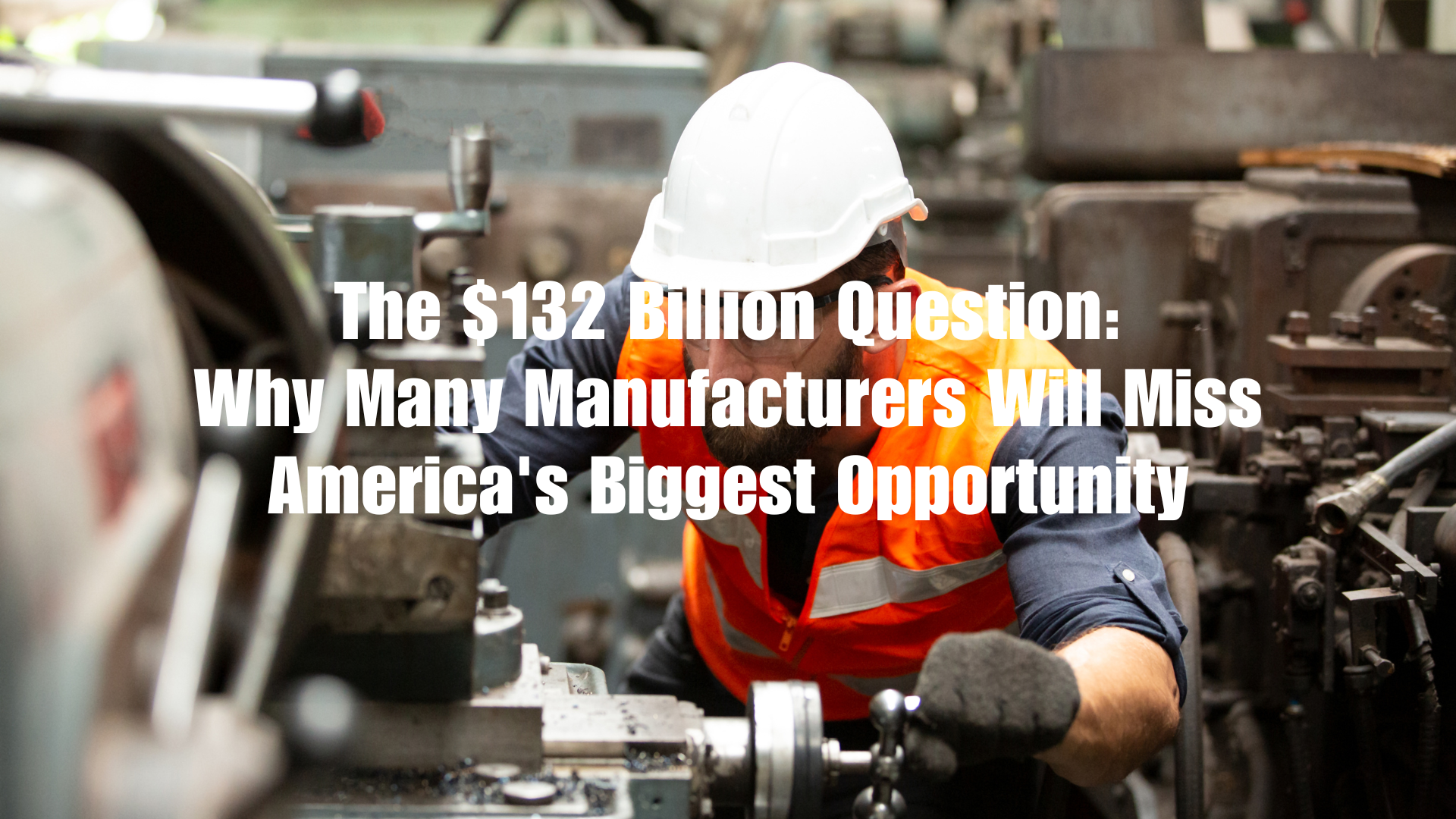The $132 Billion Question: Why Many Manufacturers Will Miss America's Biggest Opportunity
I've been funding businesses here in Detroit for over twenty years. Seen a lot of manufacturers come and go. Plants shutting down, companies packing up for Mexico or China, little shops opening up with these grand plans only to close two years later because they just couldn't make the numbers work.
It's been rough, honestly.
But something's different now. The numbers I'm seeing, the conversations I'm having with manufacturers—there's real money flowing into this space again. $132 billion in clean technology manufacturing investments. Construction spending on manufacturing hit $235 billion earlier this year. We're talking about the biggest opportunity I've seen in my career.
And many manufacturers are going to blow it.
Two Companies, Same Opportunity, Different Outcomes
Let me tell you about two automotive parts suppliers I worked with recently. Both family businesses, both been around for decades, both right here in metro Detroit.
First company comes to me needing working capital. Good reputation, solid customer base, but their equipment was showing its age. When this big opportunity came up—multi-year contract with one of the Tier 1 suppliers—they couldn't pull the trigger fast enough. Their CNC machines from 2008 couldn't hit the tolerances the customer wanted. They didn't have the cash to bring on the skilled guys they needed or buy materials upfront.
Contract went to their competitor.
The other company? They'd been investing. New Haas equipment, automated material handling, kept cash in the bank even when times were tight. Same type of opportunity knocks, and boom—they're ready. Not only did they land that contract, but it opened doors to two more major accounts.
What was the difference? It wasn't experience or connections or luck.
It was capital. Pure and simple.
The Numbers Don't Tell the Whole Story
Look, the headline numbers are encouraging. Manufacturing contributed $2.9 trillion to the economy in Q1. Manufacturers are projected to see 4.2% revenue growth this year. There's going to be 3.8 million new manufacturing jobs by 2033.
But here's what they don't mention in these reports: three-quarters of manufacturing companies have fewer than 20 employees. These aren't massive corporations with endless resources. These are small shops, family businesses, guys who started in their garage and built something real.
And when opportunity comes knocking, a lot of them just aren't ready.
I can't tell you how many times I've seen this play out. Small manufacturer gets excited about a big contract. Then reality hits. They don't have the equipment to handle the volume. No cash to buy materials upfront. No working capital to hire the people they need. The opportunity that should've been their big break becomes the thing that almost kills them.
Why This Time Feels Different
What makes right now unique isn't just how much money is flowing—it's how fast everything's moving. Real construction spending on manufacturing has doubled since 2021. Most of that growth is in computers, electronics, electrical stuff. That sector has nearly quadrupled in two years.
When things move this fast, you're either ready or you're not. There's no time to figure it out as you go.
But here's the thing that's got me a little worried. The Manufacturing Index dropped to 49 in March. Anything below 50 means the sector's contracting. Construction starts for new manufacturing facilities fell hard last year. Some forecasts are saying manufacturing construction spending might actually contract next year.
So we've got this weird situation where certain sectors are booming, but overall manufacturing is struggling. Makes it even more important to be in the right position when the right opportunity comes along.
The Money Reality
What I've learned funding manufacturers is that the capital requirements for real growth can be brutal. Single CNC machine? Half a million to two million dollars. Automated assembly line? You're looking at $5 to $10 million. And that's before you think about working capital—buying materials, paying skilled workers, covering expenses while you're ramping up.
Every dollar spent in manufacturing creates $2.64 in economic impact. That multiplier is real. But you need that first dollar to make it happen.
Too many manufacturers try to bootstrap their way through growth. Maxing out credit lines, putting off equipment purchases, running on fumes. Then a real opportunity shows up and they just don't have the financial foundation to grab it.
The manufacturers I work with who really succeed? They think about capital differently. Equipment financing isn't debt to them—it's fuel. Working capital isn't a burden—it's the foundation that lets them take on bigger customers and better contracts.
What Separates the Winners
After doing this for twenty years, you start to see patterns. Three things separate the manufacturers who thrive from the ones who struggle:
Modern equipment makes all the difference. When a customer needs 10,000 precision parts with tight tolerances in 30 days, having 15-year-old equipment just isn't going to cut it. The manufacturers investing in modern CNC equipment, 3D printing capabilities, AI-driven quality control—they can take contracts their competitors can't even bid on.
Cash flow is everything. Manufacturing's a cash flow business, period. Buy materials, add value, get paid 30 to 90 days later. The companies that master this cycle—either through cash reserves or smart working capital solutions—they can say yes when others have to pass.
Speed matters more than ever. Being able to scale up fast for new contracts, pivot to new products, adapt to changing requirements—that's a real competitive advantage now. Requires financial flexibility and operational capability.
Many of the manufacturers who miss opportunities fail on at least one of these. Outdated equipment that can't meet modern standards. Inadequate cash flow for larger contracts. Not enough flexibility to adapt quickly.
What I See Here in Detroit
Living and working in Detroit gives you a front-row seat to manufacturing's ups and downs. This city's been through tremendous challenges with manufacturing. I've watched plants close, suppliers disappear, whole neighborhoods empty out.
But I've also seen the comeback stories.
The suppliers that survived the tough years didn't just sit around waiting for better times. They invested during the downturn. Upgraded equipment, improved processes, got themselves positioned for when opportunities came back.
Now we're seeing new investment again. EV battery plants, high-tech manufacturing, advanced component suppliers setting up shop. But they're not just bringing jobs—they're raising the bar for everyone in the supply chain.
The local manufacturers winning these new contracts? They're the ones who invested in precision equipment, automated processes, quality systems. The ones struggling are still trying to compete with decades-old machinery and tight cash flow.
Being Realistic About What's Ahead
I'm not going to sugarcoat this. Manufacturing's still tough. Despite the optimistic projections, costs are still elevated. Geopolitical stuff creates supply chain headaches. The skilled worker shortage is real—1.9 million manufacturing jobs are expected to go unfilled through 2033 if we don't figure out the talent piece.
And the data's mixed. Some sectors are booming, others are contracting. The opportunities are there, but they're getting more selective and competitive.
But for manufacturers who are properly capitalized and positioned in the right markets? This is still the biggest opportunity in a generation. The companies investing in modern capabilities now—equipment, processes, cash flow management—they're going to dominate their niches over the next decade.
What This Means If You're Running a Manufacturing Business
If you're running a shop right now, decision time is here. The opportunities exist, but they're concentrated in specific sectors and they're intensely competitive. Manufacturing, warehouses, and data centers accounted for almost 40% of all industrial construction spending last year. That's where the action is.
The manufacturers investing in capabilities now are positioning themselves to win. Modern equipment, automated processes, quality systems, strong cash flow management. Those who are waiting, hoping to bootstrap through, trying to compete with outdated equipment—they're going to get left behind.
This isn't about being the biggest player or having the deepest pockets. Some of the most successful manufacturers I work with started as small shops. What separates them is their willingness to invest in growth and understanding that being properly capitalized isn't a luxury anymore—it's table stakes.
Bottom Line
American manufacturing's having a moment. Selective, concentrated in high-tech sectors, but real. $132 billion in clean tech. $235 billion in construction spending. 3.8 million jobs coming.
But opportunities don't automatically equal success. Especially in a market that's getting more competitive and selective. Takes preparation, investment, execution.
The manufacturers who get this and act on it are going to thrive. Those who don't will watch from the sidelines while others capitalize on the biggest concentrated manufacturing opportunity we've seen in decades.
From where I sit, working with manufacturers across the country, I'm cautiously optimistic about what's ahead for the ones who are prepared. But I'm also realistic about what it takes. Capital, equipment, cash flow—these aren't nice-to-haves anymore. They're the price of admission.
The opportunity's there. Selective, competitive, but real.
Question is: are you ready for it?
Charles M. Barr is the founder of LVRG Business Funding, headquartered in Detroit. Since 2004, LVRG has provided comprehensive capital solutions to manufacturers nationwide, including working capital financing, SBA loans, and big ticket manufacturing equipment financing up to $100 million, facilitating over $1 billion in manufacturing growth through direct funding and strategic partnerships.

